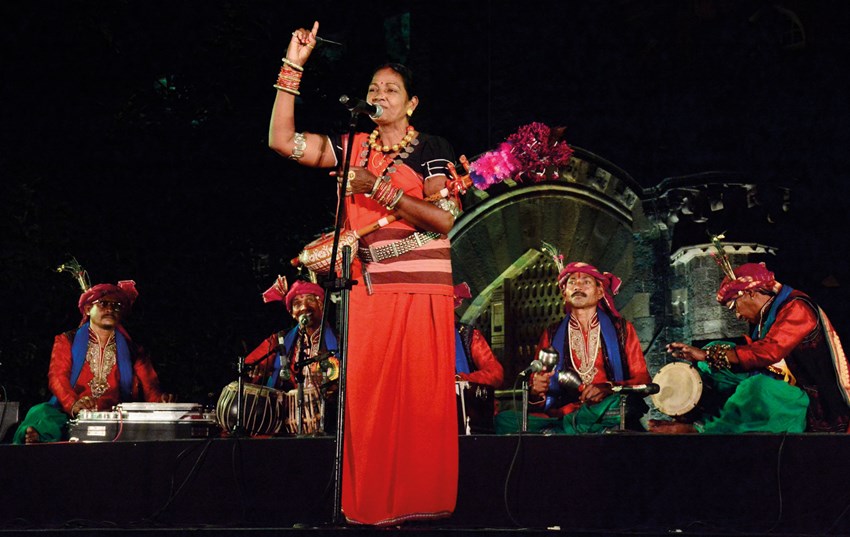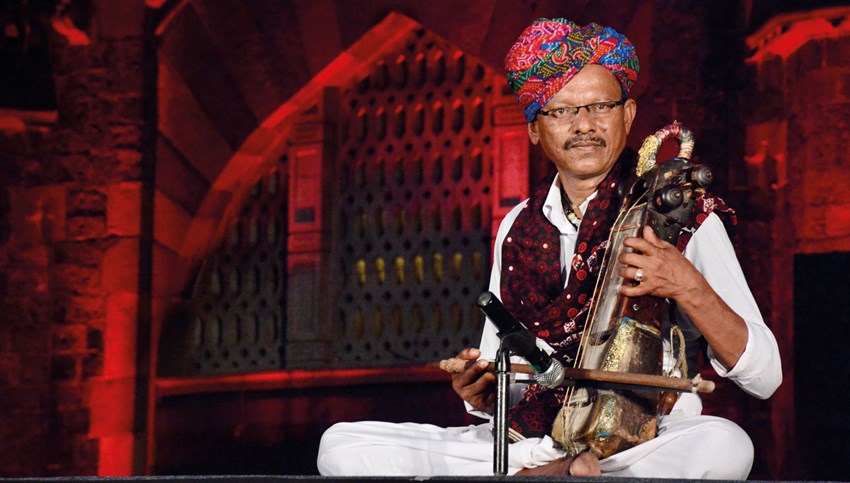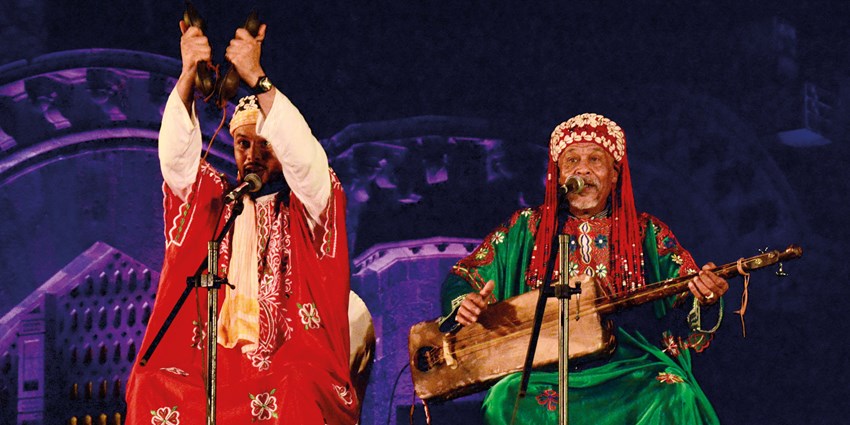Friday, October 14, 2022
Exploring the Ruhaniyat festival: “recharge the batteries of your soul”
Simon Broughton heads to Mumbai, India for a remarkable spectacle of Sufi and mystic music

Nandesh Umap (photo: Simon Broughton)
The sun goes down in the early evening and huge bats start to flit among the trees surrounding the Mumbai museum; it’s a super atmospheric location for spiritual sounds. The music begins with the bowing of a solo sarangi – maybe the bats are intrigued by the high scratchy overtones!
The museum, Chhatrapati Shivaji Maharaj Vastu Sangrahalaya (originally Prince of Wales Museum), is an example of Indo-Saracenic, with a Mughal-style dome, pointed arches and spiky pinnacles. Its grounds are home to a festival that features sacred music from different parts of India, as well as international artists. For over 20 years, the husband-and-wife team of Mahesh Babu and Nandini Mahesh, and their organisation Banyan Tree, have built up an incredible network of artists in the musical styles with which India is richly blessed. “This country’s living traditions and intangible heritage still take us by surprise today,” says Nandini Mahesh. “We both feel we knew a lot about it, but with each passing year we are discovering how little we know. There are numerous diamonds, waiting to be discovered even today!”

Nandesh Umap (photo: Simon Broughton)
I totally understand what she means as I watch Nandesh Umap, who performs regional folk styles from Maharashtra called gondhal and bharud. First of all, he’s a striking figure, dressed in 50 metres of cloth with cowrie shell necklaces and decoration. He’s got a powerful voice, singing in Marathi, and he whirls and dances in a vibrant stage performance. There are seven backing singers and three instrumentalists on Indian harmonium, a dholak-style drum called naal and a funky, double talking drum, sambal, which sounds like something from West Africa. All of this creates a glorious spectacle, like a Hindu form of qawwali, but more animated, the musicians standing, not sitting. Umap is always on the move, roaming around the stage in an ecstatic dance. The songs are for female deities and it’s powerful Pachamama stuff. Some of them are clearly humorous and there’s lots of laughter. Umap says, after a marriage, they often sing gondhal all night. Why this hasn’t been seen in the West I can’t imagine, but it seems most Indians are also unaware of these traditions. Which, of course, is the point of Ruhaniyat and what makes it so remarkable.
Ruhaniyat means ‘soulfulness’ and it seems the sources are endless in India. The festival I visited was in November 2019. Due to COVID it didn’t take place in 2020, but returned in 2021 with live local performances and streamed international artists. In 2019, international artists include Taiwanese pipa player Chia-Ning Liang, Spanish flamenco singer Pere Martínez and guitarist Tomas Lorenzo, Guinean kora player N’Faly Kouyaté and Moroccan Gnawa musician Abdenbi El Gadari. Each of them collaborates with an Indian artist, creating something unique, but on the whole it’s the various traditions in their pure, traditional form that I enjoy most.

Samsu Khan (photo: Simon Broughton)
On that first night of the festival, Meena Sahu, a tribal singer from Bhilai, Chhattisgarh in central India, sang Pandvani – telling stories from the Mahabharata, mostly of Arjuna the archer. There is also a group from three settlements near Jaisalmer, Rajasthan, performing outside of their villages for the first time. They were singing songs of Meera-Bai (or Mirabai), one of the most beloved of saints who was devoted to Krishna. ‘Even if I make ink out of the seven seas,’ they sing, ‘it is not enough to write Krishna.’ The usual finale is qawwali, in this case performed by one of the best-known groups, the Nizami Bandhu from Nizamuddin in Delhi. They are the seventh generation of singers and they began with an Amir Khusrau song about him meeting the saint and scholar Nizamuddin for the first time directly from the tradition of their shrine.
“The purpose of Ruhaniyat is to discover these little-known traditions and put them on the stage for the first time,” explains Mahesh Babu. Nandini Mahesh adds that it’s sometimes a difficult process: “Often they don’t think of them as art forms, but just an aspect of everyday life. Sometimes they are ashamed of their traditions, thinking them primitive or old-fashioned. With Meena Sahu, we had to keep going back to the village to reassure her. It’s sometimes a process of two or three years.”

Abdenbi El Gadari with qaraqab accompanist Ayoub El Mrabt (photo: Simon Broughton)
The following evening there are more musicians from Rajasthan singing the poetry of Kabir with a mixture of Hindu and Muslim musicians in the band. From Rajkot in Gujarat comes Hemant Chauhan singing devotional bhajans. He too is following on from several generations in his family and describes how his grandfather would sing to 200 or 300 people without a microphone. He is certainly not shy or ashamed of his music and says he’s recorded over 7,000 traditional songs, a world record!
It is also excellent to hear N’Faly Kouyaté playing solo. I’d only ever seen him previously as part of Afro Celt Sound System. He’s got a lovely soft voice, which fits beautifully with the delicate kora. On stage he thanks the sponsors – Tata Consultancy Services – “for putting all these people on stage like nowhere else.”
The qawwali finale is the Hifzur Rahman Hakimi group from Kota, Rajasthan – a great opportunity to hear a regional group. They include a kind of electric banjo, which adds a wildness to the sound and contrasts nicely with the bearded lead singer who possesses the air of a school teacher. He sings of the masjid (mosque) and mandir (temple) and that it probably doesn’t matter which you go to. It’s a splendid soul-stirring finish which sends you home uplifted into the night air. If you are in or near Mumbai at the right time I can’t think of a better way to recharge the batteries of your soul. And while there, it’s certainly worth spending a few hours in the museum – many of the stories that inspire the evenings’ music, from the Mahabharata to the Ramayana and other tales, are depicted in glorious historic paintings and sculptures.
➤ Ruhaniyat’s Mumbai edition takes place on November 26-27, 2022
➤ Check the festival’s website for other forthcoming Ruhaniyat events taking place in Delhi, Kolkata, Bengaluru, Hyderabad, Chennai, Ahmedabad and Pune into 2023, www.ruhaniyat.com
This article originally appeared in the October 2022 issue of Songlines magazine. Never miss an issue – subscribe today

